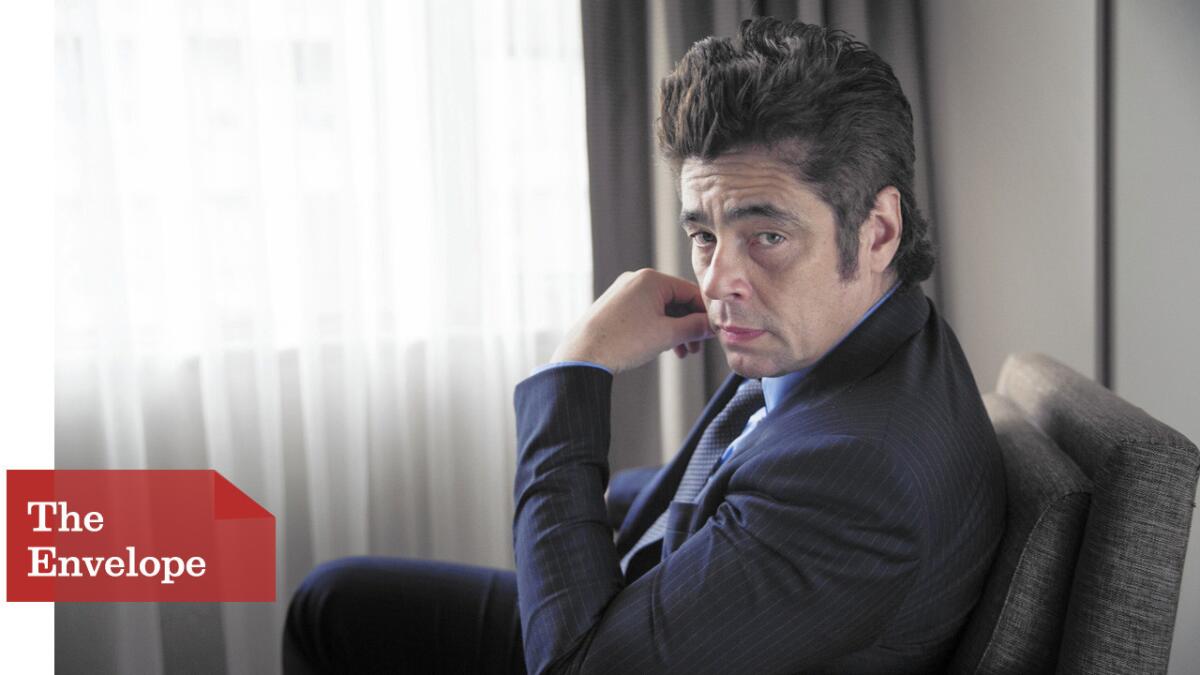Benicio Del Toro knows you’ve seen him in drug war stories — but none were like ‘Sicario’

Benicio Del Toro was having a moment. Just days after the release of his latest film, “Sicario,” a dark drug war thriller from Oscar-nominated director Denis Villeneuve, news broke of a possible sequel.
Meanwhile, sci-fi fans blew up Twitter after reports that Del Toro would portray a new villain in “Star Wars: Episode VIII” and reprise his character the Collector in “Guardians of the Galaxy: Vol. 2.”
In “Sicario” (Spanish for “hit man”), Del Toro is the titular character, a man poisoned and empowered by 20 years of drug war barbarism. He plays opposite Emily Blunt and Josh Brolin, who are American operatives desperate to beat back the murderous cartels from the U.S.-Mexico border.
SIGN UP for the free Indie Focus movies newsletter >>
It’s familiar territory for Del Toro, 48, who’s made his name on drug war characters. In a 1990 Emmy-winning TV miniseries, he played real-life undercover DEA agent Enrique “Kiki” Camarena, and 10 years later won an Oscar for his turn as a conflicted Mexican cop in Steven Soderbergh’s “Traffic.”
Earlier this fall, in a compact room at the Sunset Marquis, Del Toro shared his meandering thoughts with The Envelope, musing how his portrayals tracked the evolution of the drug war. Soft-spoken and modest, the actor at one point quipped, “Sometimes I think I dreamed this stuff.”
You have a lot of experience in this genre as an actor. What drew you back into this world?
I think I’ve played almost every angle in the drug war world. I don’t remember all my movies, but I don’t think I’ve played that character driven by revenge in any of them. [Director Denis] Villeneuve was enthusiastic. He had a vision. [Venerated cinematographer] Roger Deakins is one of the reasons I’d decided to do the film too. Josh Brolin and Emily Blunt, I’ve known for a long time. They’re motivators in a way because I don’t care what anybody says as soon as you get in front of a camera, working with a director you consider good, you’re going to try to impress them. You just do a little more work where you concentrate a little bit harder [with] a little bit more discipline.
Didn’t you shoot two different versions of one particularly violent scene?
Yeah. I felt like my guy was an eye for eye. Or an eye for an eyelid. Denis felt like that too. So his decision to wipe the table, in my opinion, was the way to go. The studio was concerned. And I understand that. And he understood that. He compromised. Why don’t we do both versions? We did ours first. Make sure we got that one right. But we did it fast.
And your version made it?
It was the scene that scored the highest [with test audiences]. It was a scene that shocked them and probably put the film into a different angle.... I think people are jerked by the darkness [of this film]. It’s part of what this movie is trying to do and I understand people might not like these movies because they’re too violent or whatever, but that’s what [the drug war] is.
What have you learned after all these years depicting the drug crisis?
I did a TV miniseries called [“Drug Wars: The Camarena Story”], which was about a DEA agent … who went to Mexico and was killed. It was just the beginning of the Mexican side of the drug wars. From 2000, when I shot “Traffic,” to 2015, I’ve made friends in my personal life with DEA agents, people that are on the front lines of this war. The maneuvers of how the drugs are being shipped, it’s changed drastically.
One thing that hasn’t changed is the production of drugs has not diminished and the consumption of drugs has not diminished. One bit. But the violence has hit all-time highs.
I just read that for the first time ever Mexico is allowing extradition for some 12 or 13 drug dealers into the United States.... I’m not running for office, OK? I don’t want to get political, but I do believe there might be a way to work with both governments. The people need to get involved in this too. The Mexican government can’t do anything about the violence. It has evolved into something else.
More to Read
From the Oscars to the Emmys.
Get the Envelope newsletter for exclusive awards season coverage, behind-the-scenes stories from the Envelope podcast and columnist Glenn Whipp’s must-read analysis.
You may occasionally receive promotional content from the Los Angeles Times.






